When we talk about prepping, most people think about food stockpiles, ammo, and water storage. But there’s another layer to survival that doesn’t always get the spotlight it deserves: medicine.
If you’ve ever been out in the woods with a cut that won’t stop bleeding or a pounding headache miles from your gear, you already know why this matters. Pharmaceuticals run out. Pharmacies close. And once the supply chain dries up, you’re left with whatever nature is still offering.
That’s where the knowledge of medicinal plants you can forage all year round comes in. These aren’t seasonal luxuries. They’re the tough, resilient, always-available species you can rely on in January blizzards, July heat waves, or anywhere in between. Knowing them is like carrying a hidden pharmacy in your head. And here’s the kicker, you don’t need to memorize a hundred species. A solid dozen or so will cover pain, infections, respiratory issues, digestive problems, and more.
Medicinal plants you can forage all year round:
Willow (Salix spp.)
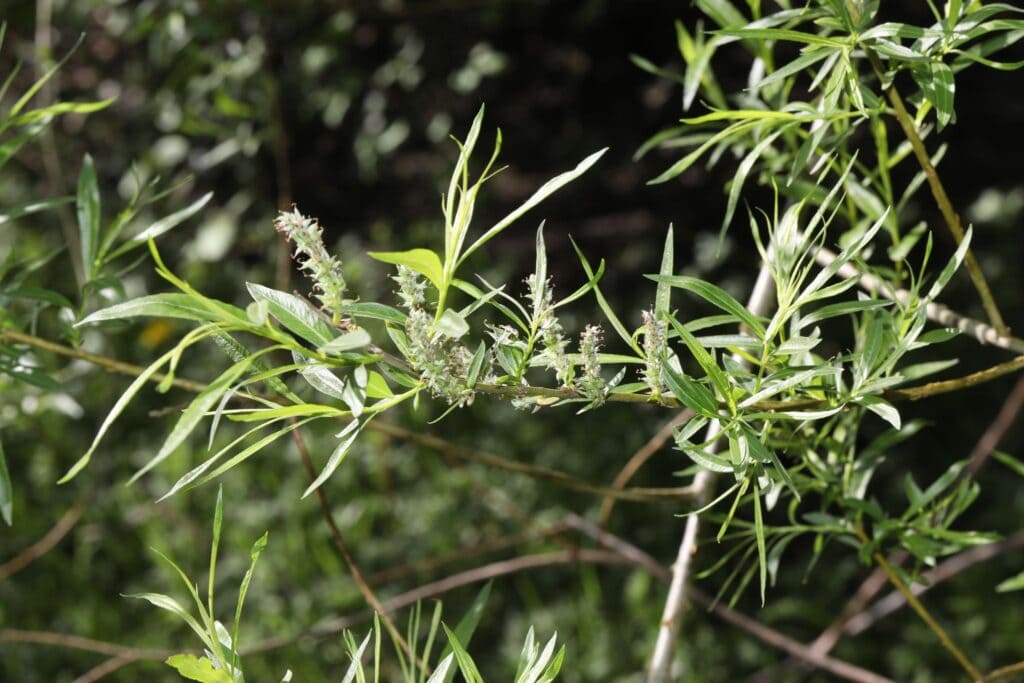
Willow trees are one of the most reliable medicinal plants you can forage all year round, since their bark remains usable even in the dead of winter. Found near streams, rivers, lakes, and other moist ground across the U.S., willows are easy to identify if you know what to look for. The trees have long, slender leaves that are finely serrated along the edges, and their flexible branches often droop downward. In winter, when leaves have dropped, focus on the smooth to rough grayish bark and the unmistakable tendency of the tree to grow right at the water’s edge.
The inner bark of willow contains salicin, a natural compound closely related to aspirin. Stripping a small section of bark and brewing it into tea can ease headaches, reduce fever, and soothe sore muscles. Historically, Native American tribes used willow bark poultices for wounds and joint pain. For preppers, this is an invaluable year-round remedy when pharmacies are inaccessible.
Caution: Willow should not be used by people allergic to aspirin, and overdosing can cause stomach upset or worse. Also, don’t confuse willow with unrelated shrubs, youthful branches should bend easily without snapping, a key identification marker.
Plantain (Plantago major)
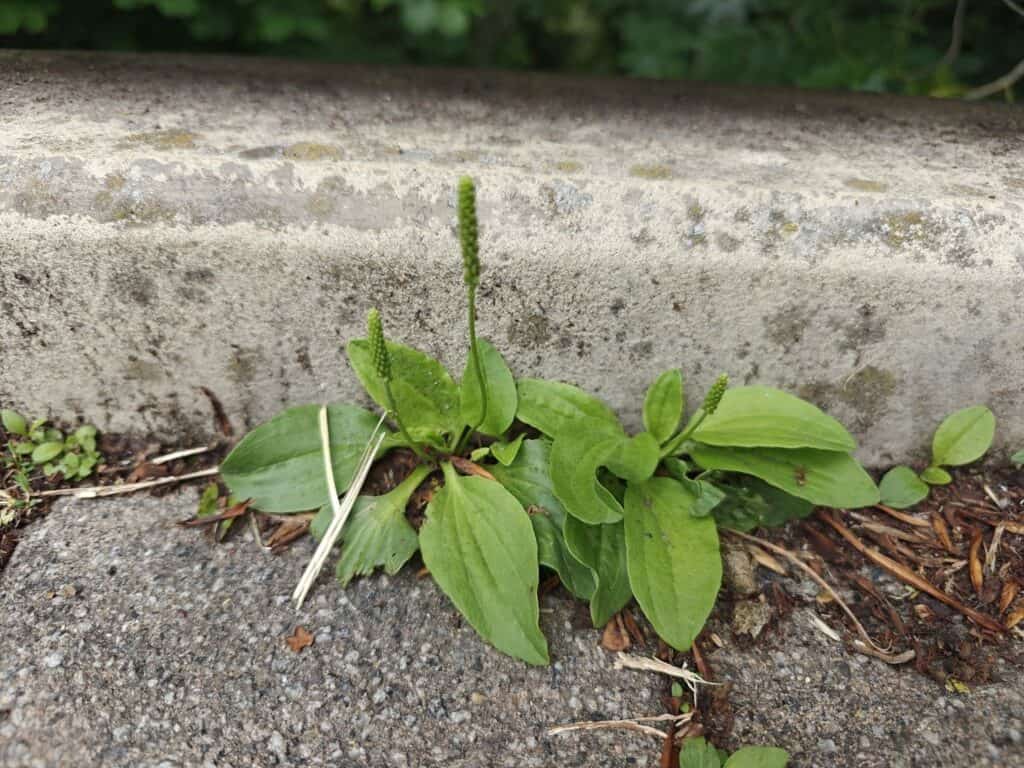
Plantain is one of the most accessible and dependable medicinal plants you can forage all year round, making it a must-know for preppers and survivalists. Not to be confused with the tropical fruit, this broadleaf weed thrives in lawns, fields, roadsides, and almost any disturbed soil. Its defining feature is a low-growing rosette of oval leaves with pronounced parallel veins. During spring and summer, a tall, spike-like flower stalk rises from the center, producing tiny, inconspicuous seeds, but even under snow or frost, the basal leaves persist, providing a year-round medicinal source.
Plantain is a true first-aid powerhouse. The leaves can be crushed and applied directly to wounds, cuts, insect bites, or stings to reduce inflammation and promote healing. Tea made from the leaves supports digestion and can ease respiratory irritation. Its mucilaginous compounds provide a soothing effect on the skin and digestive tract, and it has mild antimicrobial properties that make it effective in improvised field medicine.
Caution: Although plantain has very few toxic lookalikes, always confirm identification before use, especially in areas where it may grow alongside similar-looking invasive species. Overharvesting in a small patch can reduce local availability, so forage responsibly. For preppers, plantain is a living, reliable “bandage and tonic” that can supplement a home pharmacy and remain accessible regardless of season.
Pine (Pinus spp.)

Pine trees are some of the most widespread and versatile medicinal plants you can forage all year round, providing both nutrition and field-ready remedies. Across the United States, from the Appalachian ranges to the western Rockies, pines dominate forests and woodlands, making them easy to locate. Identification is straightforward: look for needle clusters called fascicles—white pine has five needles per bundle, red pine two, and pitch pine three. The cones vary in size and shape, but they are always woody and distinct. Pine bark is rough, and the resinous sap is sticky, bright amber when fresh, and exudes a sharp pine scent.
Medicinally, pine needles are rich in Vitamin C, which can be brewed into a tea to prevent scurvy, support the immune system, or soothe respiratory issues. The resin has antiseptic properties, useful for sealing minor cuts or burns in survival situations. Even the cambium—the thin, green layer beneath the bark—can be scraped and eaten as an emergency carbohydrate source. For preppers, pine offers an all-year, multipurpose remedy when conventional medicine isn’t available.
Caution: Never confuse pine with toxic lookalikes like yew (Taxus spp.), which has flat needles and red berries and is deadly. Harvest needles and resin responsibly; avoid stripping entire branches, and always wash hands after handling resin, as it can irritate skin. Pine is a cornerstone among medicinal plants you can forage for reliable, year-round benefits.
Spruce (Picea spp.)
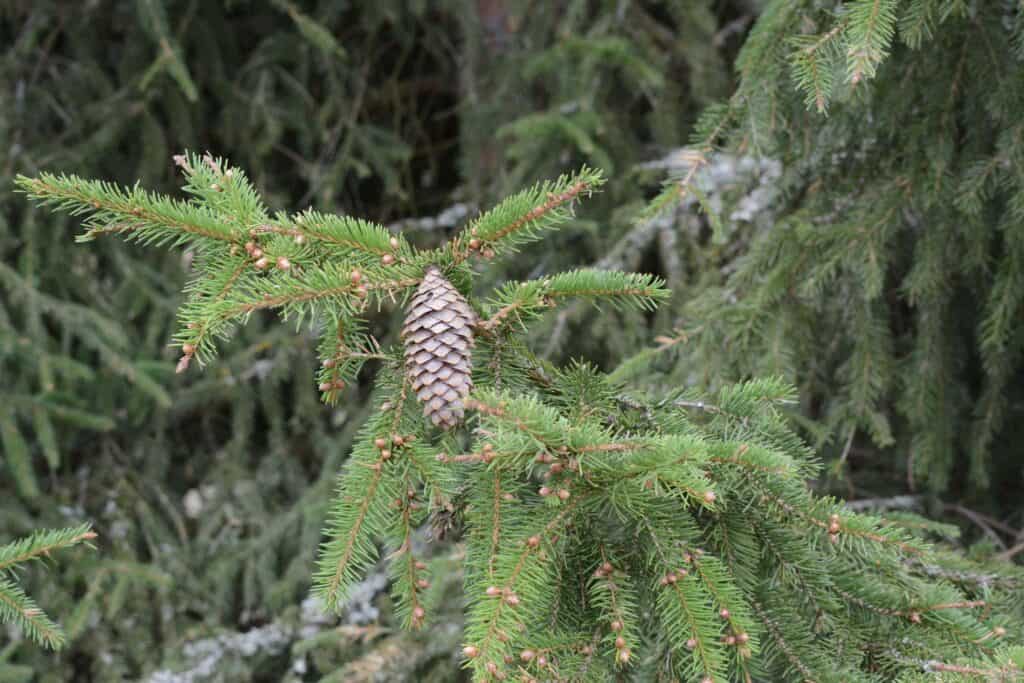
Spruce trees are another reliable entry on the list of medicinal plants you can forage all year round, offering both immune support and wound care in survival scenarios. They’re found throughout North America, from boreal forests of Canada down into northern U.S. states, often growing in mixed stands with firs and pines. Identification is key: spruce needles are stiff, sharp, and square in cross-section, so you can roll them between your fingers. Unlike firs, their cones hang downward from branches, and bark is rough with scaly plates on mature trees. Spruce tends to thrive in cooler, moist environments, making it highly visible even in winter months when snow covers the ground.
Medicinally, spruce needles are rich in Vitamin C and antioxidants, making a tea that soothes colds, coughs, and respiratory irritation. The resin can be applied directly to cuts, scrapes, or burns as a natural antiseptic, and historically, Native Americans also chewed the resin for sore throats. In a survivalist context, spruce offers both immediate and long-term benefits: the needles, bark, and resin are available year-round, ensuring you always have access to basic medicine.
Caution: Avoid harvesting from trees growing in polluted areas, and be careful not to confuse spruce with toxic lookalikes. Proper identification is critical to safely reap the benefits of medicinal plants you can forage. Spruce is a sturdy, all-season ally for any prepper’s natural pharmacy.
Birch (Betula spp.)

Birch trees are an essential entry among medicinal plants you can forage all year round, prized for their bark, leaves, and sap. White birch (Betula papyrifera) is the most iconic, with smooth, papery white bark that peels in thin sheets, while yellow and black birches are also common and equally medicinal. Birches thrive in moist, well-drained soils, often along streams, forest edges, and clearings. In winter, when leaves are gone, the distinctive bark and slender, flexible branches make identification straightforward.
Birch bark and leaves have long been used for medicinal purposes. The bark contains betulin and salicylates, compounds that can reduce fevers, ease joint pain, and support kidney and liver function. Leaves can be brewed into a tea to help flush the urinary system and ease mild inflammation. The cambium layer beneath the bark is edible in emergencies and provides mild nutrition. For preppers, birch is a dependable year-round resource: bark can be stored dried for teas or poultices, and sap collection in spring adds extra vitamins when available.
Caution: Never strip large sections of bark from a living tree; overharvesting can kill it. Misidentification is rare if you focus on the white, papery peeling bark and distinctive lenticels, but always double-check guides. For anyone serious about self-reliance, birch remains a cornerstone among medicinal plants you can forage through every season.
Burdock (Arctium lappa)
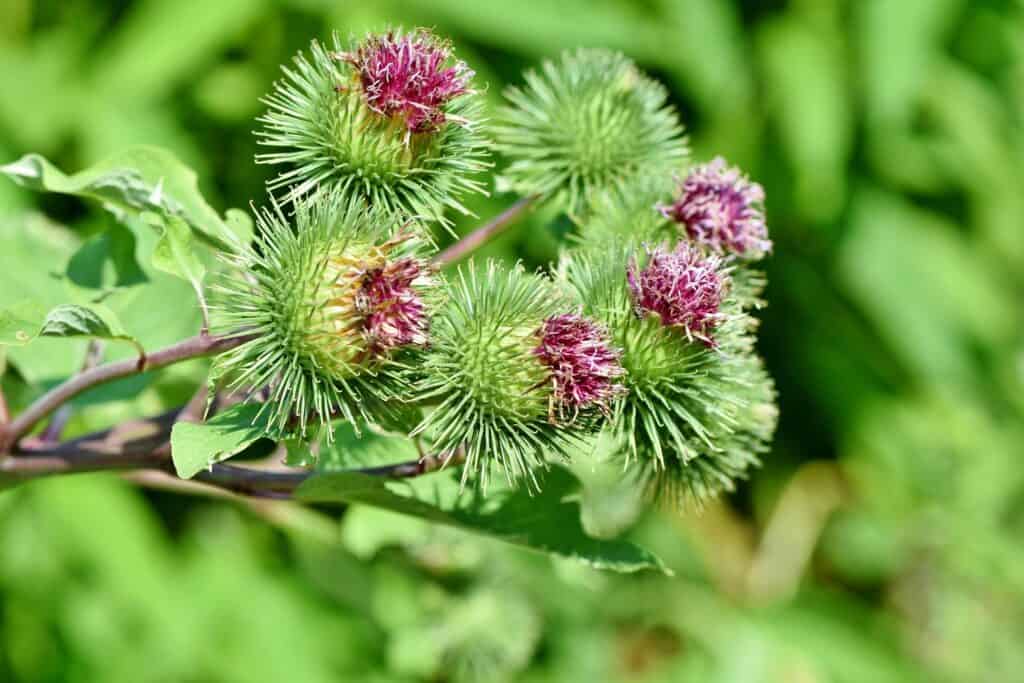
Burdock is a hardy and highly practical entry among medicinal plants you can forage all year round, particularly valued for its deep, nutritious roots. Native to Europe but widespread throughout the U.S., burdock thrives in disturbed soils, along roadsides, fields, and forest edges. The plant is easily recognized by its large, heart-shaped leaves—sometimes more than a foot across—and its spiky burrs that cling stubbornly to clothing or animal fur. Even in winter, the root remains viable underground, offering a consistent survival resource.
The root is the main medicinal component, containing compounds like inulin and arctigenin, which support liver detoxification, blood purification, and skin health. Traditional uses include teas to help with acne, eczema, and general “body cleansing.” Burdock can also be eaten as an emergency starch source, though it’s fibrous, it stores well when dug, washed, and dried. For preppers, this plant is a multi-purpose ally: it provides nutrition, medicine, and even seeds for potential propagation.
Caution: Burdock can be confused with young rhubarb leaves or foxglove seedlings, both potentially toxic. Always confirm identification by leaf shape, burr formation, and flower stalks in season. Harvest responsibly, leaving some roots to maintain local populations. Mastering medicinal plants you can forage like burdock ensures a reliable, year-round addition to any survivalist’s natural pharmacy.
Dandelion (Taraxacum officinale)
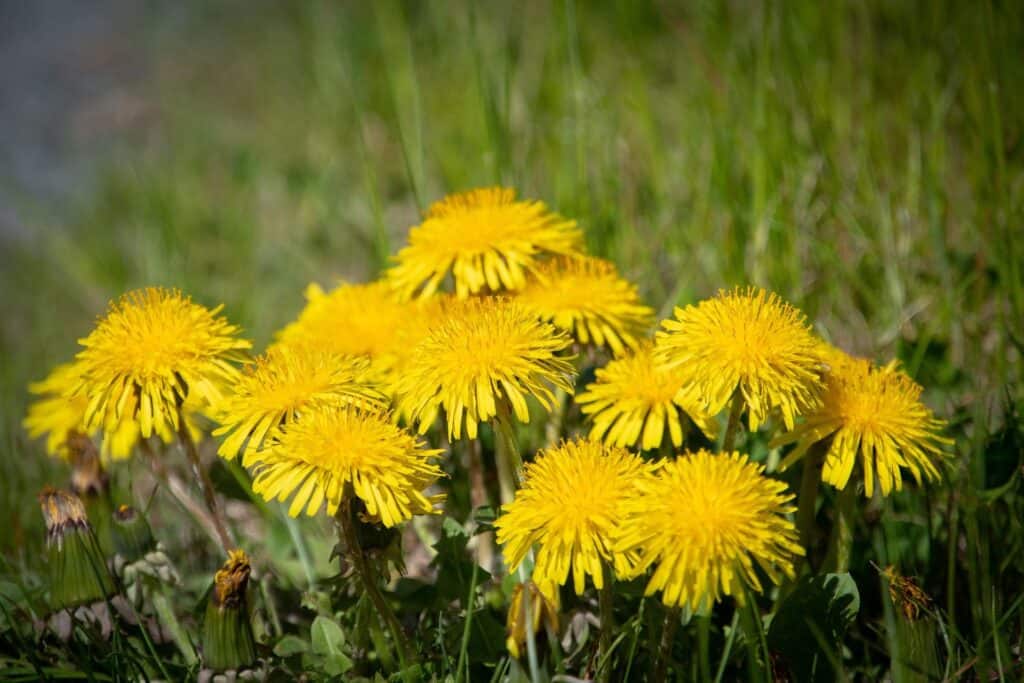
Dandelion is one of the most resilient and useful entries among medicinal plants you can forage all year round, thriving in lawns, fields, roadsides, and almost any disturbed soil across the U.S. Its basal rosette of jagged, “lion-tooth” leaves remains green even under snow, making it a reliable source of medicine during winter. In warmer months, it produces bright yellow flowers on hollow stalks, followed by iconic seed heads, but the plant’s basal leaves and roots are what keep it useful year-round.
Medicinally, dandelion is a powerhouse. The root, rich in compounds like taraxacin and inulin, supports liver and kidney function, promotes digestion, and can even act as a mild diuretic. Leaves can be used in salads or brewed as tea to support detoxification and provide essential vitamins and minerals. Dandelion sap can be applied topically to warts or skin irritations, and tea from roots or leaves soothes digestive or urinary issues. For preppers, it’s a dependable, edible medicine that requires no specialized storage, making it a cornerstone of year-round survival healthcare.
Caution: Avoid harvesting near roadsides or industrial areas due to heavy metal contamination. While generally safe, proper identification is essential to avoid confusion with similar-looking weeds. Learning medicinal plants you can forage like dandelion equips preppers with a versatile, always-available remedy that complements any natural pharmacy.
Cattail (Typha spp.)
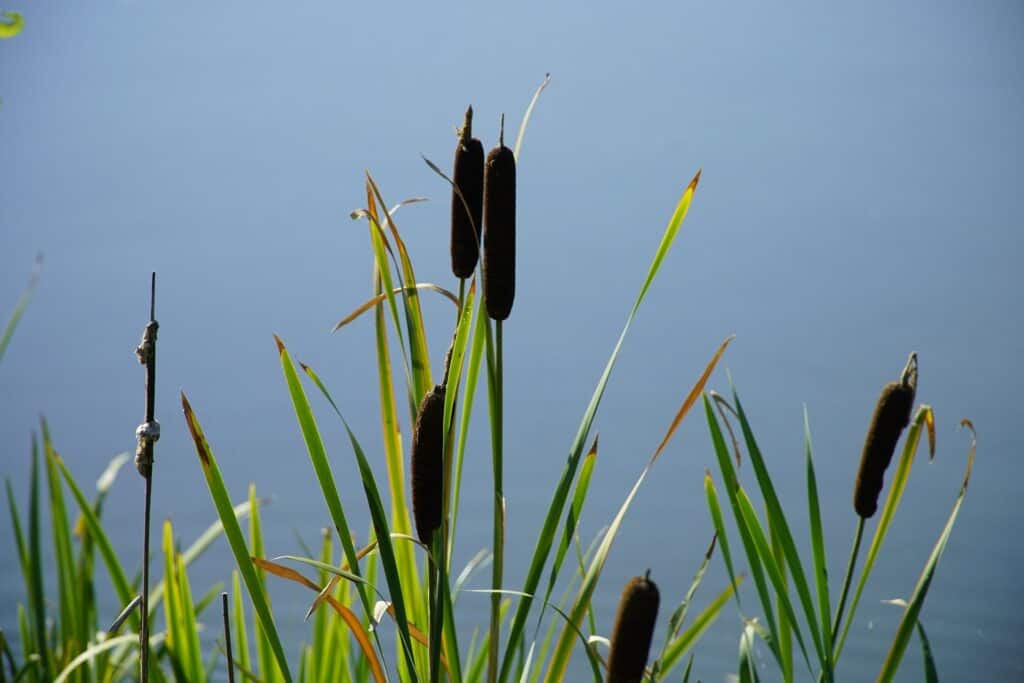
Cattail is a quintessential survival plant and a standout among medicinal plants you can forage all year round, particularly in wetland areas across the U.S. It grows along ponds, marshes, lakes, and slow-moving streams, forming dense stands that are easy to spot. The plant is unmistakable: tall, upright stalks topped with brown, sausage-shaped flower heads in summer. Even in winter, the stalks remain, and the rhizomes beneath the mud are accessible with a digging tool, providing both nutrition and medicinal utility.
Medicinally, cattail is versatile. The rhizomes can be boiled into a starchy poultice that soothes burns, wounds, and skin irritations. The pollen, though seasonal, can be dried and stored as a source of protein and carbohydrates. The fluff from seed heads has been historically used as a natural absorbent dressing for bleeding wounds. Emergency foragers also turn the shoots and rhizomes into edible food during scarcity, making cattail an indispensable multi-purpose plant.
Caution: Avoid harvesting from polluted or chemically treated wetlands, as cattails readily absorb contaminants. Proper identification is essential: don’t confuse with bulrushes or sedges, which may have sharp edges or toxic compounds. For preppers, mastering medicinal plants you can forage like cattail guarantees a reliable, year-round resource that combines food, medicine, and field utility in any survival scenario.
Garlic Mustard (Alliaria petiolata)
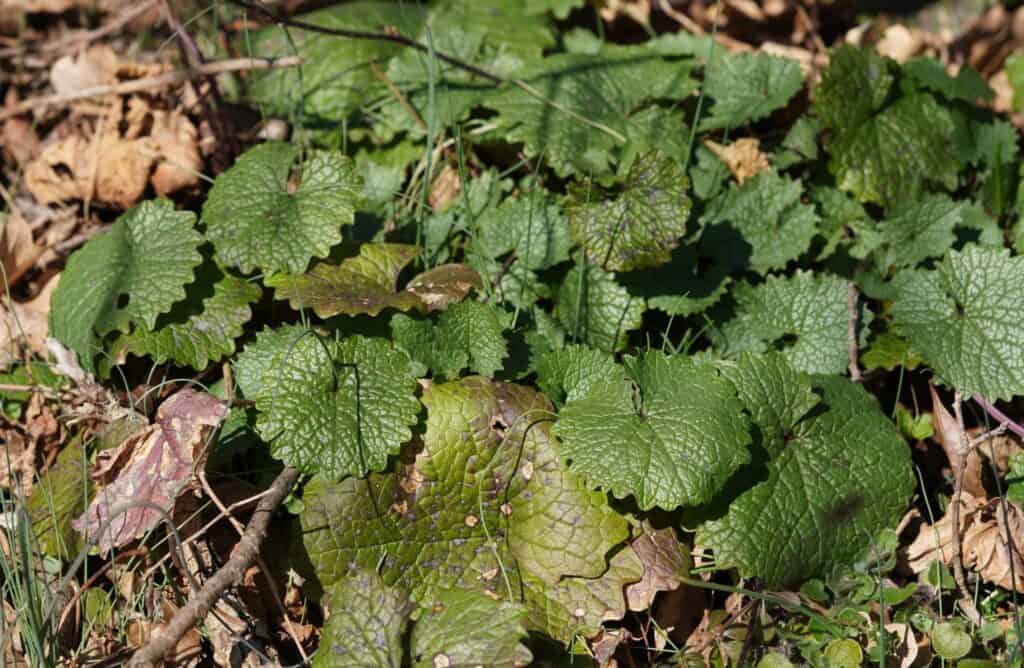
Garlic mustard is a highly practical addition to the list of medicinal plants you can forage all year round, especially for preppers seeking reliable and accessible remedies. Originally from Europe, it has become widespread across North America, particularly in wooded areas, forest edges, and shaded disturbed soils. Identification is straightforward: the leaves are heart-shaped with toothed edges and release a strong garlic odor when crushed. In spring and summer, the plant produces small, four-petaled white flowers, followed by slender seed pods. Even after the flowering season, the basal leaves and root system remain available, making it a year-round resource.
Medicinally, garlic mustard offers antimicrobial and digestive support. The leaves can be used in teas or poultices for minor wounds, while the crushed foliage can act as a natural antiseptic. Internally, small amounts in salads or cooked preparations may aid digestion and provide trace vitamins. For preppers, its invasive nature is an advantage: the plant thrives aggressively, so harvesting it doesn’t deplete local populations. Its constant availability means you can rely on it in emergencies when other seasonal herbs are scarce.
Caution: While generally safe, overconsumption can cause digestive upset. Never confuse garlic mustard with edible wild onions, which have a similar scent but different leaf shapes. Familiarity with medicinal plants you can forage like garlic mustard ensures preppers have dependable, year-round remedies without relying on cultivated herbs.
Wild Onion & Garlic (Allium spp.)
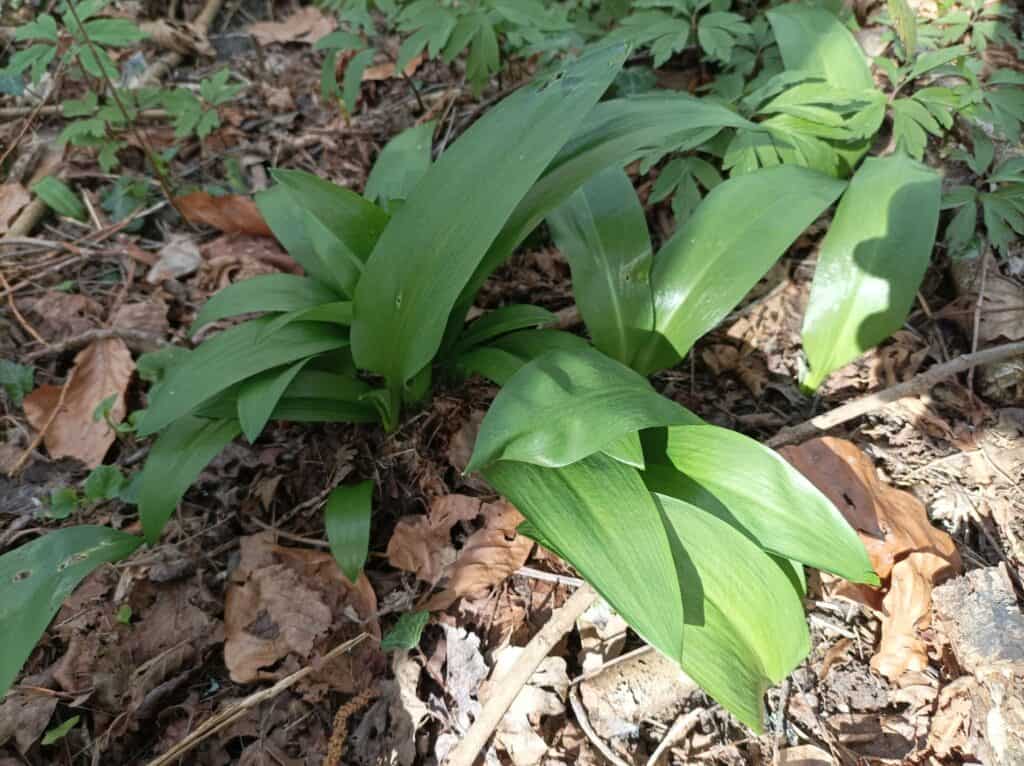
Wild onions and garlic are indispensable in any list of medicinal plants you can forage all year round, offering both culinary and therapeutic benefits. These hardy species grow throughout the U.S., from open meadows to forest edges, often in clumps. Identification is relatively straightforward: their long, grasslike leaves emit a distinct onion or garlic aroma when crushed, and the small bulbs grow underground. In late spring and early summer, you may notice clusters of white, pink, or purple flowers atop slender stalks, though the leaves and bulbs remain accessible through most seasons, especially in milder climates.
Medicinally, wild onions and garlic contain allicin, a potent antimicrobial compound that supports the immune system and helps combat infections. Teas, tinctures, or raw consumption can bolster cardiovascular health, act as a natural antibiotic, and stimulate digestion. For preppers, these plants are invaluable year-round: bulbs store well, leaves are easy to harvest, and their strong flavor enhances otherwise bland survival meals. They’re also easy to propagate, ensuring a continual source even if foraging opportunities are limited.
Caution: Correct identification is critical. Death camas (Zigadenus spp.) is a deadly lookalike with grasslike leaves but no onion smell. Always crush and sniff leaves before consumption. Learning medicinal plants you can forage like wild onion and garlic equips preppers with a reliable, year-round natural remedy that is both nutritional and therapeutic.
Usnea (Lichen)
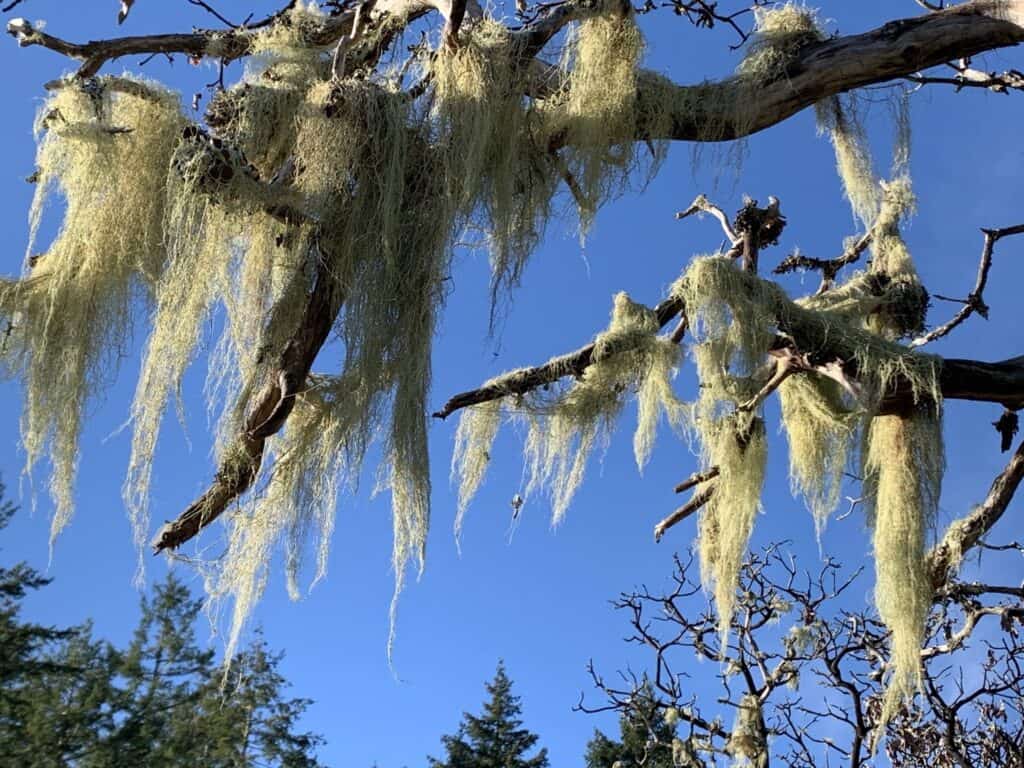
Usnea, often called Old Man’s Beard, is a remarkable addition to medicinal plants you can forage all year round, offering natural antimicrobial properties in survival situations. This pale green, hair-like lichen drapes from tree branches in clean, forested areas across much of the U.S., especially in the northern states and mountainous regions. Identification is key: Usnea strands are thin, slightly elastic, and contain a white core. Unlike mosses, they are not rooted in soil and grow almost exclusively on trees in well-ventilated, pollution-free environments.
Medicinally, Usnea is highly valued for its antibacterial and antifungal compounds, particularly usnic acid. It can be brewed into tea to help fight infections or used as a poultice for minor cuts and abrasions. Historically, indigenous peoples and early settlers relied on Usnea for wound care, respiratory support, and even as a mild antiseptic for internal use when other remedies were scarce. For preppers, its year-round availability on evergreen or deciduous trees in clean air zones makes it a reliable natural pharmacy addition, especially when traditional medicine is inaccessible.
Caution: Only collect Usnea from unpolluted areas, as it readily absorbs airborne toxins. Proper identification is essential to avoid confusing it with other non-medicinal lichens. Knowing medicinal plants you can forage like Usnea ensures preppers maintain access to a safe, natural antibiotic throughout the seasons.
Sphagnum Moss

Sphagnum moss is a unique and indispensable member of medicinal plants you can forage all year round, particularly valued for its historical and practical uses in wound care. This spongy moss grows in bogs, wetlands, and damp forest floors throughout much of the U.S., forming thick mats that retain moisture while providing natural antiseptic properties. Identification is fairly straightforward: Sphagnum moss is pale green to yellowish, soft, and stringy with a fibrous texture, growing in dense clumps that remain recognizable even under snow or frost.
Medicinally, Sphagnum moss acts as a natural absorbent and antiseptic, historically used to dress wounds, control bleeding, and reduce infection risk during wartime before modern bandages were widely available. Its ability to hold moisture makes it ideal for packing wounds or even creating emergency compresses in the field. Preppers can harvest and dry the moss for long-term storage, ensuring a year-round supply for first aid. Additionally, its insulating and moisture-retentive properties have applications in emergency shelter or insulation for medicinal plant storage.
Caution: Only collect Sphagnum moss from clean, uncontaminated wetlands. Avoid areas exposed to pesticides, industrial runoff, or polluted water. Mastering medicinal plants you can forage like Sphagnum moss gives preppers a natural, reliable, and versatile wound-care option available in any season, bridging the gap when modern supplies run low.
Juniper (Juniperus spp.)
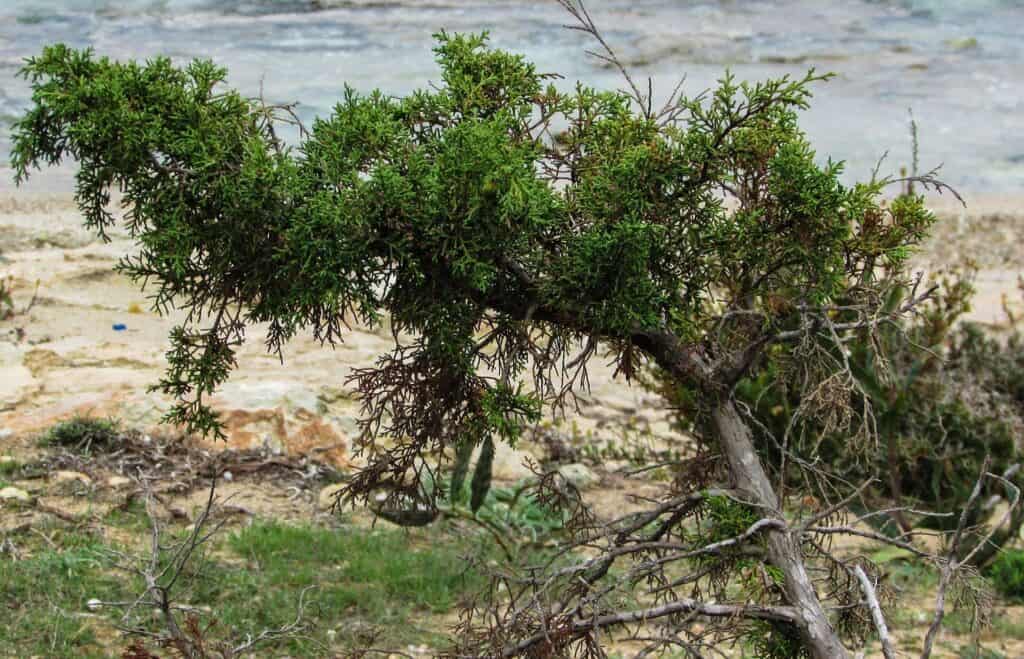
Juniper is a hardy and versatile addition to medicinal plants you can forage all year round, thriving across much of the U.S., from arid western landscapes to northern forests. Identification is fairly simple: most junipers are evergreen shrubs or small trees with needle-like leaves that are sharp or scale-like, and they produce characteristic blue or bluish-purple berry-like cones. The bark is thin and fibrous, peeling in some species, and the resin has a distinctive, sharp scent. Junipers remain green throughout the year, providing reliable year-round access to both medicinal and survival resources.
Medicinally, juniper berries contain compounds with antiseptic and diuretic properties, making teas or tinctures useful for urinary tract support, digestive aid, and mild inflammation. The berries can also flavor food, while the crushed needles can be used in poultices for skin irritations. Historically, juniper has been a staple in survivalist herbal medicine for its versatility, availability, and long shelf life when dried. For preppers, its constant year-round presence ensures access to a natural remedy even in winter when other herbs are dormant.
Caution: Some juniper species, like Juniperus sabina, are toxic. Proper identification is essential; always focus on berry color, needle arrangement, and growth habit. Understanding medicinal plants you can forage like juniper ensures preppers have dependable, multi-purpose remedies no matter the season.
Yarrow (Achillea millefolium)

Yarrow is a versatile and resilient entry among medicinal plants you can forage all year round, often considered a must-have for any prepper’s natural pharmacy. Found across the U.S. in meadows, roadsides, forest edges, and even urban wastelands, yarrow is easy to recognize. Its feathery, fern-like leaves remain green in many mild winter areas, while in spring and summer, flat-topped clusters of tiny white or pale pink flowers bloom. The plant’s distinctive aroma—a mix of herbal and slightly spicy notes—also helps with identification.
Medicinally, yarrow is celebrated for its anti-inflammatory, antiseptic, and astringent properties. Crushed leaves or flowers can be applied directly to minor cuts, scrapes, or insect bites to staunch bleeding and prevent infection. Tea made from leaves or flowers can support digestion, reduce fevers, and soothe colds. Yarrow’s hardiness and widespread availability make it a reliable year-round resource: even in winter, dried stalks or leaves retain medicinal value. For preppers, it’s a multi-purpose ally, offering first aid, digestive support, and even pest-repelling properties in emergency scenarios.
Caution: Avoid confusing yarrow with poisonous lookalikes such as poison hemlock; focus on leaf shape, flower clusters, and aroma. Mastering medicinal plants you can forage like yarrow ensures a prepper maintains consistent access to natural remedies throughout the seasons, no matter the environment.
Rose (Rosa spp.)

Rose, particularly its hips and roots, is an exceptional entry among medicinal plants you can forage all year round, offering both nutritional and therapeutic benefits. Wild roses, such as Rosa rugosa or Rosa canina, are widespread across the U.S., commonly found along fence lines, fields, and forest edges. Identification is straightforward: pinnate leaves with serrated edges, thorny stems, and fragrant flowers in spring and summer. The bright red or orange hips remain on the plant into late fall and even winter, making them accessible when most other fruits are gone.
Rose hips are packed with Vitamin C, antioxidants, and flavonoids, making them excellent for immune support, digestive health, and skin care. They can be brewed into teas, made into syrups, or dried for long-term storage. Roots, although less commonly used, can be boiled to create mild medicinal teas for gastrointestinal support. For preppers, wild roses provide a reliable, year-round source of both nutrition and medicine.
Caution: Always correctly identify wild roses, as some lookalikes like multiflora rose are invasive but not toxic. Be careful handling thorns during harvest. Familiarity with medicinal plants you can forage like rose ensures preppers maintain access to a safe, potent, and seasonal-proof natural remedy.
Chicory (Cichorium intybus)

Chicory is a resilient and highly useful entry among medicinal plants you can forage all year round, thriving along roadsides, pastures, and open fields throughout the U.S. Identification is relatively simple: it has bright blue, daisy-like flowers in summer, rough, lobed leaves forming a basal rosette, and a thick, tan taproot that persists through winter. Even after flowering, the leaves remain edible and medicinal, making it a reliable year-round resource.
Medicinally, chicory roots and leaves contain inulin, bitter compounds, and antioxidants. The roots can be roasted and ground as a caffeine-free coffee substitute, supporting digestion and liver function. Leaf teas help stimulate appetite, soothe digestive discomfort, and provide mild anti-inflammatory benefits. Historically, European settlers relied on chicory as a natural tonic, and its hardy nature makes it a staple in prepper foraging. For survivalists, chicory is valuable not only as a medicinal plant but also as a nutritional backup, with edible roots and greens that can be harvested throughout the year.
Caution: Ensure proper identification; chicory can be confused with wild lettuce or other bitter roadside weeds. Only harvest from areas free of pesticides or pollutants. Understanding medicinal plants you can forage like chicory ensures preppers have a dependable, multi-use resource accessible in every season.
A final word
Knowing medicinal plants you can forage all year round isn’t just an interesting hobby, it’s survival insurance. You don’t need every herb in the forest. You just need to know the handful that never abandon you, no matter the season.
The truth is, the day will come when supply chains falter, or you simply find yourself stranded without your kit. When that happens, the prepper who can look at a frozen cattail marsh, a stubborn patch of plantain, or a pine stand heavy with resin will be the one who doesn’t just survive, but keeps their people alive and healthy.
Useful resources to check out:
10 Things Cowboys Carried With Them In The Wild West To Survive
A few survival food recipes everyone needs to learn
The vital self-sufficiency lessons our great grand-fathers left us


